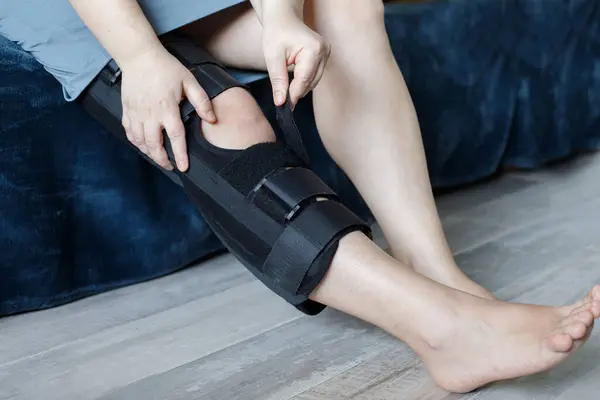5 essential exercises to relieve torn meniscus or knee pain and restore mobility, a torn meniscus can be a painful and limiting injury, affecting your ability to perform daily activities and enjoy sports. Fortunately, specific exercises can help alleviate knee pain and restore range of motion. In this article, we will explore what causes a torn meniscus, its symptoms, the benefits of recovery exercise, and the five best exercises to aid your rehabilitation.
What Causes a Torn Meniscus?
A torn meniscus occurs when there is damage to the cartilage that cushions the knee joint. Understanding the causes of this injury is essential for prevention and effective treatment.

Common Causes
- Sports Injuries: Many meniscus tears occur during sports activities that involve sudden stops, twists, or impacts. For example, athletes playing football, basketball, or soccer are particularly vulnerable. According to the American Academy of Orthopaedic Surgeons (AAOS), meniscus tears are among the most common knee injuries in athletes.
- Degenerative Changes: In older adults, meniscus tears often result from wear and tear over time. As we age, the cartilage becomes less flexible and more prone to injury. A study published in the Journal of Bone and Joint Surgery found that degenerative tears account for nearly 60% of all meniscal injuries in individuals over 65.
- Types of Tears: There are various types of meniscal tears, including radial tears, horizontal tears, and complex tears. Radial tears are particularly common in the medial meniscus (the inner cartilage) and can lead to significant pain and instability.
Understanding these causes can help individuals take preventive measures, such as strengthening knee muscles and practicing proper techniques during physical activities.
Symptoms of a Torn Meniscus

Recognizing the symptoms of a torn meniscus is crucial for prompt diagnosis and treatment. Common symptoms include:
- Pain: Pain is often localized to the knee joint and may worsen with movement or weight-bearing activities.
- Swelling: Swelling can develop within hours after the injury due to fluid accumulation in the joint.
- Popping Sensation: Many individuals report feeling a “pop” at the time of injury, indicating a potential tear.
- Limited Range of Motion: Difficulty bending or straightening the leg fully is common following a meniscal tear.
- Knee Locking or Catching: Some may experience a sensation that the knee is stuck or unable to move smoothly due to fragments of cartilage interfering with joint movement.
If you experience these symptoms after an injury or notice gradual onset pain, it’s essential to consult a healthcare professional for an accurate diagnosis.
The Benefits of Exercises for Torn Meniscus
Engaging in targeted exercises offers numerous benefits for individuals recovering from a torn meniscus:
- Pain Reduction: Research indicates that exercise therapy can effectively reduce knee pain associated with meniscal injuries. A study published in Physical Therapy found that patients who engaged in structured exercise programs reported significant reductions in pain levels compared to those who did not participate in such programs.
- Improved Functionality: Regular exercise enhances knee function and stability. A systematic review in The American Journal of Sports Medicine concluded that exercise therapy improves functional outcomes for patients with knee injuries, allowing them to return to daily activities more quickly.
- Strengthening Muscles: Strengthening the muscles surrounding the knee joint provides better support and stability. Strong quadriceps and hamstrings help absorb shock during movement, reducing stress on the meniscus. The AAOS recommends strengthening exercises as part of rehabilitation for knee injuries.
- Enhanced Range of Motion: Specific exercises can help restore lost mobility in the knee joint. A study from The Journal of Orthopaedic & Sports Physical Therapy showed that patients who performed range-of-motion exercises after a meniscal tear experienced improved mobility compared to those who did not engage in such activities.
Incorporating these benefits into your rehabilitation plan can significantly enhance recovery outcomes following a torn meniscus.
The 5 Best Exercises for a Torn Meniscus
Here are five effective exercises that can help ease knee pain and restore range of motion:
1. Quadriceps Activation (Isometric Contractions)
Purpose: Strengthens the quadriceps without stressing the knee joint.
How to Do It:
- Sit comfortably on a flat surface with your legs extended.
- Tighten your quadriceps (the muscle on the front of your thigh) without moving your leg.
- Hold this contraction for 5-10 seconds.
- Relax and repeat for 10-15 repetitions.
This exercise helps maintain muscle strength while minimizing strain on the injured area.
2. Hamstring Curls
Purpose: Strengthens hamstrings to support overall knee stability.
How to Do It:
- Lie face down on a flat surface.
- Bend your knees slowly, bringing your heels towards your glutes.
- Hold briefly at the top before lowering back down.
- Perform 10-15 repetitions on each leg.
Hamstring curls help balance muscle strength around the knee joint, which is crucial for recovery.
3. Straight Leg Raises
Purpose: Engages multiple muscle groups while improving range of motion.
How to Do It:
- Lie on your back with one leg bent at the knee and the other leg straight.
- Lift the straight leg towards the ceiling while keeping it aligned with your body.
- Hold for a few seconds before lowering it back down.
- Aim for 10-15 repetitions on each side.
This exercise strengthens both quadriceps and hip flexors without putting undue stress on the knee joint.
4. Heel Slides
Purpose: Aids in regaining flexibility in the knee joint.
How to Do It:
- Sit with your legs extended in front of you.
- Slowly slide one heel towards your glutes while keeping your foot flat on the ground.
- Return to starting position.
- Repeat for 10-15 repetitions on each leg.
Heel slides promote mobility by encouraging smooth movement within the knee joint while gently stretching surrounding muscles.
5. Clamshell Exercises
Purpose: Targets hip abductors for better knee stabilization.
How to Do It:
- Lie on your side with knees bent at a 90-degree angle.
- Keep your feet together while lifting your top knee away from your bottom knee.
- Hold briefly at the top before lowering back down.
- Perform 10-15 repetitions on each side.
Clamshell exercises strengthen hip muscles that play a vital role in stabilizing the knee during movement.
Conclusion
Recovering from a torn meniscus doesn’t have to mean prolonged inactivity or discomfort. By understanding what causes this injury and recognizing its symptoms, you can take proactive steps toward recovery through targeted exercises designed to alleviate pain and restore range of motion.
Incorporating these five effective exercises into your rehabilitation program can significantly enhance recovery outcomes and allow you to return to an active lifestyle more quickly. Always consult with a healthcare professional before starting any new exercise regimen, especially following an injury, to ensure safety and effectiveness tailored to your specific condition.
Also Read | Expert recommendations for management of people with hip and knee osteoarthritis










